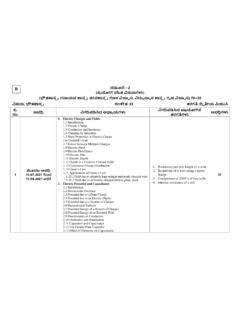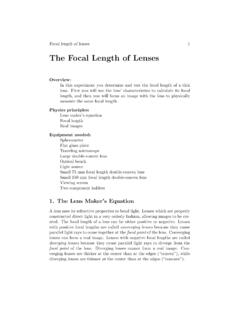Transcription of E. coli Gram Staining
1 E. coli Gram Staining Written and Directed By: Colton Anderson Table of Contents iii Table of Contents Table of iii Introduction .. v Materials & Preparation .. 1 Materials and 3 Materials .. 3 Pre-Lab Preparation .. 3 Gram Stain Lab .. 5 Preparing the organism .. 7 Heat fixing .. 7 Gram Staining .. 8 Viewing Under the Microscope .. 11 Using the Microscope .. 12 Viewing your organism .. 12 Index .. 15 Introduction v Introduction It is important to be aware of the correct way to stain an organism. Without knowing the right way to do it you could potentially harm yourself and your lab partners. In this manual, you will be given direction on how to perform a simple gram stain of the E. coli bacteria. 3 Materials & Preparation In this section, we will gather all of the necessary materials to safely execute the lab procedure. 3 Materials and Preparation Materials 1 Bunsen Burner 1 Inoculating loop 1 Striker (to light the burner) 1 Vial of E.
2 Coli 1 Microscope 1 Vial of Immersion oil 1 Vial of crystal violet dye 1 Vial of Gram s Iodine 1 Vial of Decolorizer 1 Vial of Safranin dye 1-3 Viewing slides 1 Container of Lysol wipes 4 Pre-Lab Preparation Before and after any lab, clean your hands and your lab area with your Lysol wipes. Also light your Bunsen burner at the beginning of the Gram Stain Lab In the next section, we will go over how to prepare your organism and how to properly stain it. 7 Preparing the Organism Heat fixing Heat fixing is a lab term in which the person doing the lab takes a sample of their organism on a slide and heats it over an open flame to fix it to the slide. First, take your inoculating loop and insert it into your vial of E. coli. Next, take the loopful of bacteria and apply it to one end of the slide. 8 After letting the slide dry out for one minute, heat-fix the organism by swiping it back and forth over the flame till all the liquid is gone.
3 Gram Staining Now that the slide has been heat fixed, you may now begin to stain the organism. This is started by applying a few drops of crystal violet for 30 seconds, then rinsing with water for 5 seconds. Next, cover the slide with Gram s Iodine and let sit for a full minute before rinsing with water for another 5 seconds. 9 After rinsing off the iodine, rinse off again with decolorizer for 5 seconds followed immediately by water for another 5 seconds. Lastly, counterstain with safranin and let sit for 30 seconds before briefly rinsing with water. 10 Now that you are finished Staining the organism, dry it off gently with paper towels. Forcing the towel against the slide may wipe off the organism. Index 11 Viewing Under the Microscope No surprises here, in the next section, you will be instructed how to correctly use the light microscope to view your organism at its full power.
4 12 Using the Microscope A few things to know about the microscope before using: A basic light microscope has 4 objective lenses 4X, 10X, 40X, and 100X. The higher the number, the higher the power of magnification. Once you have focused the microscope, you will cycle between these to get a better image of the organism The stage controls move the stage side to side, and back and forward. Use this to position the inoculated end of your slide over the lens. The coarse and fine focus raise and lower the stage. This will help you focus the image at any objective. IMPORTANT The 100X lens can only use the fine focus, using the coarse knob will completely lose the image of your bacteria and you will have to start back at 4X. The 100X also requires the use of immersion oil to reduce the refraction of light . The diaphragm controls the intensity of light and will help you better contrast the image of the organism with the lit background.
5 Now to the viewing Viewing your organism This part of the manual will not have pictures due to everyone slides being slightly different. First, plug in and turn on your microscope. Make sure the diaphragm is also turned up to full power for the moment. Second, place your slide on the stage and adjust with the stage controls until the slide is directly under the viewing lens. Now set your objective lens (the rotating ones) to 4X power and view under your microscope. Use the coarse adjuster to find your organism. You won t see anything definite but just look for the giant color stains(they should be pinkish). Index 13 Now shift to 10X and refocus again on a more specific spot. This step is repeated again with the 40X magnification although using the fine adjuster is accepted her as well. Now before switching to the 100X magnification, apply a drop of immersion oil onto the part of the slide directly under the lens.
6 Now, using the fine adjuster ONLY, focus in onto your organism. Those of you using E. coli will see something like this. Index 15 Index E. coli, 1, v, 3, 7, 13 Heat fixing, iii, 7 Materials, iii, 1, 3 Microscope, iii, 3, 11, 12 Organism, iii, v, 5, 7, 8, 10, 11, 12, 13 Preparation, iii, 1, 3, 4 Stain, v, 5, 8 Works Cited ~kroberts/Lecture/Chapter%204





